THE CATS
Striped, spotted, with coats of many colors, shorthairs and longhairs, toms and queens, calm and coquettish, docile an d vocal, lively and laid-back, mischievous mousers and loving lap-cats: it’s time to meet and greet our stunning catalog of 40 of the finest feline models—all at one stroke. These are definitely the cat’s whiskers.
d vocal, lively and laid-back, mischievous mousers and loving lap-cats: it’s time to meet and greet our stunning catalog of 40 of the finest feline models—all at one stroke. These are definitely the cat’s whiskers.

MAINE COON

TOM
The MAINE COON, one of North America’s oldest natural breeds, was first recorded in cat literature in 1861 and was established as a breed over a hundred years ago. Assorted legends surround this cat’s ancestors: one is that because its most common color is the brown tabby, the breed began when a cat mated with a raccoon—an impossible but funny idea. It is Maine’s official state cat.
Features
This “gentle giant” of cats is distinguished by its large size, tufted ears, and snowshoe-like feet. All of this extra fur, including a famously long, bushy tail in which it can wrap itself, keeps the cat warm and allows it to walk lightly in the New England snow. Maine Coons come in about 75 different color combinations and can have brown or blue eyes, or one of each.
Temperament
This breed likes children, other pets, and is famed for its sweet disposition. It remains kittenish and enjoys playing fetch. An intelligent cat, it loves following its owners around and will not only play in water, but sometimes wash its food in it.
Similar breeds
Norwegian Forest Cat, Siberian, Turkish Van
Size
Tom |
13–18 lb (6–8 kg) |
Queen |
9–13 lb (4–6 kg) |

Origin
The Maine Coon was a wild cat found in Maine. The breed almost died out in the mid-20th century, but since then it has seen such a revival in interest that it is now the third most popular cat in the USA. It was first imported into the UK in 1984.


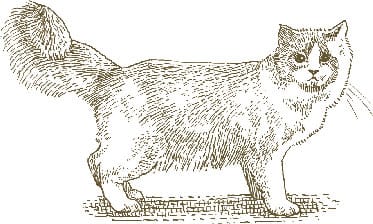
RAGDOLL

TOM
The RAGDOLL is something of an enigma. This beautiful, large, longhaired cat seems to have a special gene that makes it laid-back and relaxed in nature. Pick up a Ragdoll and it will usually go limp and floppy, just like a rag doll.
Features
This cat has a large, muscular body and striking, bright-blue eyes. Its plush, medium-length coat has colored points, including seal, chocolate, cream, and tortie, to the face, ears, legs, and tail. The Mitted Ragdoll has white front feet, white back hocks, and a natty white chin. The Bi-Color Ragdoll has more white on its legs and body and a white “V” marking on its face.
Temperament
Very docile, affectionate, and laid-back, the Ragdoll is not a vocal cat and positively enjoys being carried around, flopping contentedly in its owner’s arms. It will play happily and even learn to fetch in a dog-like way, and it mixes well with dogs and children.
Similar breeds
Birman, Snowshoe
Size
Tom |
15–20 lb (7–9 kg) |
Queen |
11–15 lb (5–7 kg) |

Origin
The Ragdoll originated in California, USA, in the early 1960s with a white longhaired female named Josephine. The story goes that Josephine was hit by a car, and after her recovery all litters born to her had limp, gentle, and docile personalities—though this is genetically impossible.



KURILIAN BOBTAIL

QUEEN
Not surprisingly, the KURILIAN BOBTAIL derives its name from its bobbed tail, the fluffy, pom-pom shape which is caused by the reduced number of vertebrae. Despite its “wild” appearance, it is a gentle, sweet-natured, and playful cat that is highly valued in Russia as a good mouser. Although it is a naturally occurring breed, the Kurilian is not recognized by all cat registries.
Features
This is a well-muscled, medium- to large-sized cat, semi-cobby and broadchested. It has a large, slightly wedge-shaped head and “walnut-shaped” eyes (oval at the top, rounded at the bottom), with ears that slope slightly forwards. Its defining feature is, of course, its rounded bobtail. The breed can be short or semi-longhaired and is bred in a diverse range of colors and markings.
Temperament
The Kurilian Bobtail is very person orientated and will give and seek affection in equal measure. It is highly intelligent, inquisitive, and playful, and enjoys playing in water. It mixes well with other animals and makes a perfect family pet.
Similar breeds
Cymric, Japanese Bobtail, Karelian Bobtail, Manx
Size
Tom |
11–15 lb (5–7 kg) |
Queen |
7–11 lb (3–5 kg) |
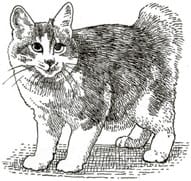
Origin
The Kurilian originated in Eastern Russia, the island of Sakhalin and the adjacent Kuril Islands. The breed has slowly gained popularity in Europe but it is only within the late-20th century that it made an appearance in North America, where its numbers are still very limited.



SELKIRK REX

QUEEN
Did you ever see a stuffed animal walking? You’ll think so when you first see a SELKIRK REX. The curly coat, which can be shorthaired and longhaired, is as snuggly as it looks. Unlike the Cornish or Devon Rex, the rex gene (which causes the coat’s curliness) in this breed is dominant. It was first seen in a kitten from a cat adopted from an animal shelter in the USA.
Features
The Selkirk Rex is a heavy boned, medium- to large-sized cat. It comes in an array of colors, with round eyes and a sweet expression that equates with its personality. But its star features are its tousled hair, curly whiskers, and plush coat—the shorthaired variety’s is more like a teddy bear while that of the longhaired variety more closely resembles a sheep’s coat. In the show ring there are two divisions for the Selkirk Rex based upon the coat length.
Temperament
With its sweet, patient, and laid-back personality, the Selkirk Rex makes a lovely and surprisingly playful companion.
Similar breeds
Cornish Rex, Devon Rex, LaPerm, Persian, Sphynx
Size
Tom |
11–15 lb (5–7 kg) |
Queen |
6–12 lb (2.5–5.5 kg) |
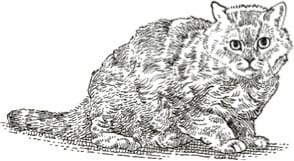
Origin
This breed originated in Montana, USA in the 1980s, when one of the five offspring of a blue tortie and white feral mother sprouted curly hair and whiskers. When fourteen months old, this kitten was bred to a black male Persian—half of the litter produced curly haired kittens.



BENGAL

QUEEN
The strikingly beautiful and clever BENGAL is the result of the first deliberate effort to create a domestic cat using a wild cat. With its sleek elegance, lithe body, and exquisite “wild cat” markings, this cat—which has a flight/flight reaction rather than fight or flight—has many admirers.
Features
The Bengal’s short, soft coat is its crowning glory. The markings are usually very vivid spots or marbeling, or it could have rosettes much like jaguars, leopards, and ocelots. Some even have “glitter,” which gives each hair an iridescent sheen. The popular black/brown tabby’s coat can be anything from gold and bronze to gray, while a form of albinism results in blue or aqua eyes and a cream or ivory coat with spots of varying shades.
Temperament
Loving, curious, and with almost frightening intelligence and energy, the Bengal wants to be where you are. This cat loves playing games and, when tired enough, enjoys sitting on its owner’s lap. Many Bengals prefer to drink running water and some will even “talk.”
Similar breeds
Burmese, Korat, Khao Manee, Siamese, Tonkinese
Size
Tom |
9–15 lb (4–7 kg) |
Queen |
6–12 lb (2.5–5.5 kg) |

Origin
The Bengal’s wild origins go back to the Asian Leopard Cat, which was crossed with a domestic cat in the 1960s by American breeder Jean S. Mill. Today’s Bengals trace to the ones Mrs. Mill began breeding in the early 1980s. The breed has since been developed by dedicated Bengal breeders around the world.



TURKISH VAN

TOM
The TURKISH VAN is a striking, semi-longhaired breed that originated, as its name suggests, in Turkey. The breed is certainly ancient, as carvings, jewelry, and ornaments dating back to the Hittites circa 1600 BCE have been uncovered, depicting cats with distinctive ringed tails and color on their heads. This breed is also known as the “swimming cat” because of its notable swimming prowess.
Features
A solid, muscular cat with long, silky soft fur and a thick brush of a tail, a Turkish Van’s most distinctive features are its white body and “van” patterning on its head and tail. The most common marking color is auburn, although it can be bred in a range of other colors.
Temperament
The Turkish Van is loving, intelligent, very active, and dog-like. It will follow its owner devotedly and will enjoy games of fetch with balls, toys, or rolled up scraps of paper. With its waterproof coat, this breed will also happily swim in ponds or swimming pools, even joining owners in the bath or shower!
Similar breeds
Maine Coon, Norwegian Forest Cat, Siberian
Size
Tom |
12–16 lb (5.5–7.5 kg) |
Queen |
12–14 lb (5.5–6.5 kg) |
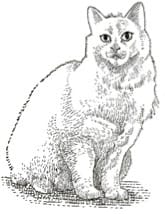
Origin
The Turkish Van originated around Lake Van, the largest lake in Turkey, where it lived in isolation for centuries until discovered by two British photographers, Laura Lushington and Sonia Halliday, in the mid-1950s. The two women took two kittens back with them to the UK, and the breed was imported to the USA soon thereafter.
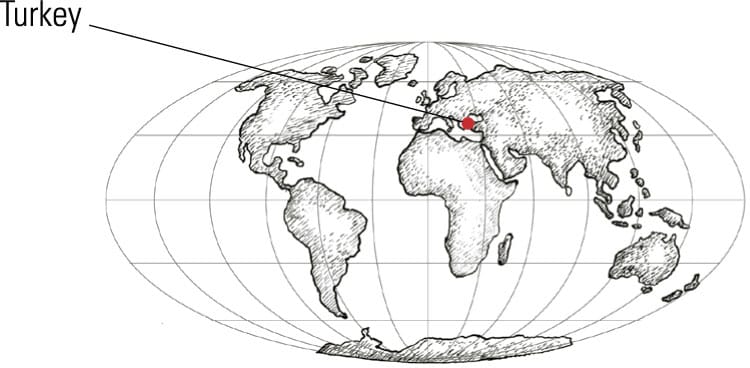


EGYPTIAN MAU

QUEEN
While fans of many of the older cat breeds are fond of saying that their breed dates back to ancient Egypt, the EGYPTIAN MAU is the one breed that can justifiably claim this honor. It is a naturally occurring breed in the region and its ancestors are depicted in artwork dating back 3,000 years. In fact, these highly intelligent cats were used as hunting animals long before they were revered as gods.
Features
This breed has a striking, spotted shorthaired coat. It has a small- to medium-sized body, slender yet muscular. The head is a slightly rounded wedge shape, with medium to large ears and large, expressive green eyes. The coat is spotted and barred, and bred in three colors: silver, bronze, and smoke. It has a distinctive dark dorsal stripe.
Temperament
This intelligent yet sensitive cat develops a close bond with its owner, seeking attention and reassurance and displaying great loyalty. The Mau is known for its distinctive vocalization—it “chirrups,” the pitch conveying its feelings.
Similar breeds
Abyssinian, American Shorthair, Ocicat, Siamese
Size
Tom |
8–11 lb (3.5–5 kg) |
Queen |
5–8 lb (2.5–3.5 kg) |
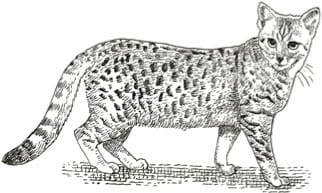
Origin
This ancient breed from Egypt was first exported in 1952 when a kitten was given to an exiled Russian princess by the Egyptian ambassador to Italy. The cat was imported into the USA in 1956 and subsequently outcrossed to similar breeds to produce the basis of the modern Mau. The first Maus were imported to the UK in the 1970s.
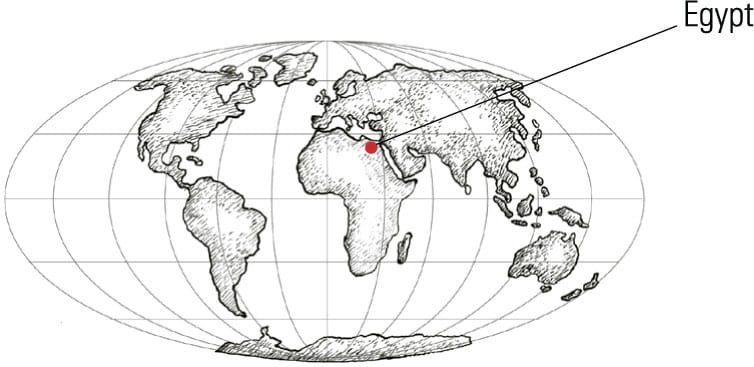


ABYSSINIAN

TOM
The ABYSSINIAN is a cat of exceptional grace and beauty; this is summed up delightfully in TICA’s breed description as a cat resembling “a small mountain lion or “cougar.” Certainly it is a very ancient breed, originaly believed to come from Abyssinia (now Ethiopia), although genetic studies have now placed the cat’s origin as being in the region of the Bay of Bengal, India.
Features
A medium-sized cat with a long, lithe body and subtle musculature, this breed has a “modified” wedge-shaped head, with large, erect ears that tilt forward slightly. Its stunning eyes, which can be green, amber, or gold, surrounded by dark and light rings of color, give it a striking expression. Its soft, finely textured coat includes ruddy (“usual”), sorrel, chocolate, red, and tortoiseshell colors.
Temperament
The Abyssinian is highly intelligent, inquisitive, and affectionate. It has strong loyalty to its owner and likes to be involved in whatever is going on. While maintaining an almost regal reserve, it can suddenly become incredibly playful. This breed enjoys company, but prefers not to be in larger pet groups.
Similar breeds
Abyssinian, Singapura, Sokoke, Somali
Size
Tom |
8–10 lb (3.5–4.5 kg) |
Queen |
6–7 lb (2.5–3 kg) |

Origin
The story goes that the first Abyssinian was a cat named “Zula” brought to England from Abyssinia in 1862 by a British soldier. There is no clear link between Zula and modern Abyssinians and the breed is now thought to have originated in India. It was established in the UK by the mid-1890s and introduced to the USA in the early 1900s.



PERSIAN

TOM
The PERSIAN is one of the most iconic and easily recognizable breeds. With its lustrous fur, round face, and big eyes, there’s no wonder that it is seen as cuddly and teddy-bear like—the perfect pet cat, in fact. Variants of this breed have appeared on chocolate boxes and greetings cards for well over a century and the Persian has entered the human psyche as the epitome of the pedigree cat.
Features
A medium to large cat, with a cobby, well-muscled body and short legs, the Persian has a round, domed head and a “flat” face that can be accentuated in some breeds as “ultra type.” It has a small nose, large eyes, and medium to small ears. Of course, the Persian’s defining feature is its long coat, with a mane-like ruff surrounding its head and a thickly furred, plumed tail.
Temperament
This cat is slightly reserved at times but essentially calm and will show affection to its owners. It will mix well with children and other pets if it has to, but usually it prefers to be the focus of attention.
Similar breeds
Exotic Shorthair, Himalayan/Colorpoint Persian
Size
Tom |
8–11 lb (3.5–5 kg) |
Queen |
7–9 lb (3–4 kg) |
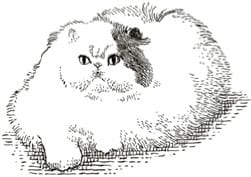
Origin
The first Persians were imported into Europe from Persia (Iran) in the 17th century and crossbred with Angoras. However, the modern breed is genetically grouped with other European breeds. It was first shown in 1871 in the UK. Persians were exported to the USA in the late 19th century and it is now an established, popular breed the world over.
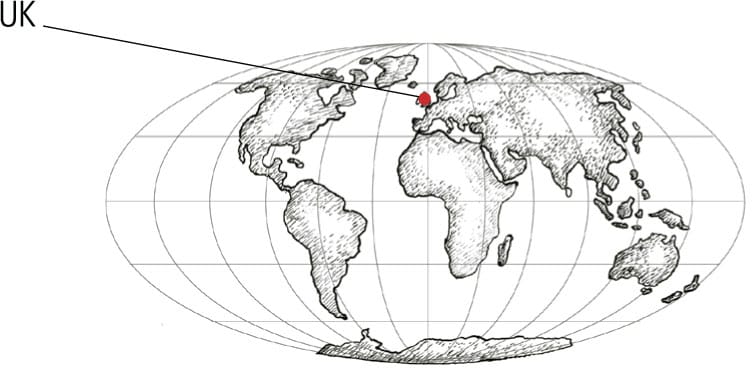

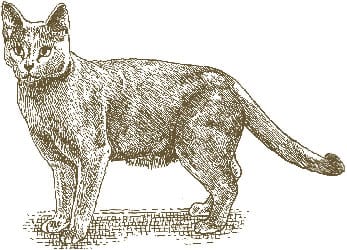
RUSSIAN BLUE (GCCF)

TOM
The RUSSIAN BLUE is a short-haired, elegant cat with a distinctive gentle expression. It is one of the oldest show breeds, having first appeared in the UK in the 1860s and arriving in the USA in the early 20th century. Most Russian Blues today are direct descendents of cats imported to the UK in the 19th century.
Features
Russian Blue breed standards vary across different associations—the UK’s GCCF type has a short wedge, prominent whisker pads and large ears as well as an elegant body with a long tail and legs. Its short, thick coat is soft and silky in texture. Coat color is medium blue, with an overall silvery sheen. The GCCF also recognizes Russian Whites and Russian Blacks.
Temperament
A highly intelligent, gentle, and affectionate cat, the Russian Blue will form a strong bond with its owners. It has a tolerant nature and is quite happy to be handled, and it is patient with dogs and children and therefore an ideal family pet.
Similar breeds
Nebelung, Russian Shorthair, Tiffanies
Size
Tom |
9–13 lb (4–6 kg) |
Queen |
8–11 lb (3.5–5 kg) |

Origin
Russian Blues were first known as Archangel cats, due to their place of origin, the Russian port of Arkhangelsk. The cats were introduced, via ship, to other European countries and formed part of the earliest roster of fancy breeds in the UK. The breed was shown at the UK’s Crystal Palace cat show in 1875.



HIMALAYAN/COLORPOINT PERSIAN

TOM
The HIMALAYAN/COLORPOINT PERSIAN is a very attractive breed of cat, but is recognized in different ways by different cat registries—while TICA treats it as a separate breed to the Persian, the CFA classifies it as a division of the Persian breed and the GCCF calls it a Colorpoint Persian. It is, however, essentially a Persian cat, with attractive “points” to its face, ears, tail, and legs.
Features
This cat has a typical Persian physique: a cobby, fairly muscular body with short legs, a round, domed head, a snub nose, and a ‘flattened’ face. It has small ears and large, round eyes, with a long, lustrous coat and brush-like tail. Its points are its most striking feature, and these come in a wide range of colors.
Temperament
This is an intelligent cat, affectionate toward its “special human.” It has a calm disposition, although occasionally may be given to random bursts of mischief. It integrates well with human families and other pets. It isn’t overly vocal, but has a very expressive face. This makes its feelings on a given matter very clear!
Similar breeds
Exotic Shorthair, Persian
Size
Tom |
9–12 lb (4–5.5 kg) |
Queen |
7–9 lb (3–4 kg) |

Origin
An experimental breeding program to combine the traits of Persian and Siamese cats was undertaken in the 1930s at Harvard University, USA, while formal breeding programs took place separately in the UK and USA in the early 1950s, both of which helped to produce the cat we see now.



CORNISH REX

QUEEN
The CORNISH REX is a very distinctive breed of cat, with its long body covered in tightly curled down. Highly sought after by cat fanciers the world over, the Cornish Rex is also a firm favorite for pet cat owners as it integrates very well into family life. Alert, intelligent, and totally handsome, the Cornish Rex knows it’s a cut—or a wave at least—above the hoi poloi.
Features
This breed has a slender, lithe yet solid and muscular body, with a naturally arched back and tapering tail. A patrician, Roman nose, tall, high-set ears, and oval eyes give it a very distinct expression. Of course, it is the downy fur, which falls in waves, either loose or tight, over the body, which stands out. Coat color can vary from solid to tabby.
Temperament
This sociable cat thrives on being in the thick of the action! Highly intelligent and playful, affectionate and loyal, the Cornish Rex is the ideal family pet and mixes well with other pets. It tends to have a slightly higher body temperature than other breeds and enjoys lying in warm places.
Similar breeds
Devon Rex, LaPerm, Selkirk Rex, Siamese, Sphynx
Size
Tom |
8–10 lb (3.5–4.5 kg) |
Queen |
5–7 lb (2.5–3 kg) |

Origin
As its name suggests, the breed originated in Cornwall, UK. In 1950, a Siamese queen gave birth to a litter of five kittens, one of which had a distinctive curly coat, the first “Rex.” Subsequent crosses with Siamese, Havanas, and American and British Shorthairs fixed the Cornish Rex in the form it is now known.


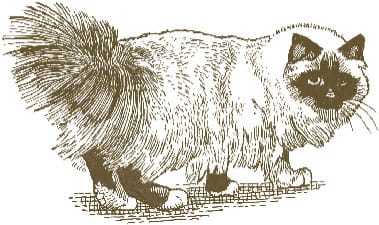
BIRMAN

TOM
The BIRMAN is perhaps best known for the Burmese legend, in which a beautiful white cat stood watch while the high priest died. Upon the priest’s death, his soul was transferred to the cat, whereupon its coat turned brown and cream while its paws and hocks, where it had sat on the priest’s chest, remained white. The cat looked up at the priest’s golden goddess and its eyes turned as sapphire blue as hers.
Features
This lovely, medium-sized longhaired cat is cream colored, with points coming in a range of colors. All four feet are white with laces halfway up the back legs. The Birman’s face is round and features a Roman nose. It has stunning, rather round, sapphire blue eyes and a soft, chirping voice.
Temperament
Very sweet natured, a Birman gets along well with other pets and with children but can also live as an only pet. Gentle and patient, but playful, it is a wonderful companion that enjoys participating in whatever its owner is doing. A Birman can become “verbal” if its owner talks to it.
Similar breed
Ragdoll
Size
Tom |
8–12 lb (3.5–5.5 kg) |
Queen |
7–9 lb (3–4 kg) |
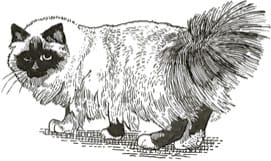
Origin
The Birman was originally from Burma (now Myanmar). Although it is unknown when it was first exported, it was first recognized in France in the 1920s and the UK and USA in the 1960s. Most Birmans can be traced to France, the UK, Australia, and Germany although genetically it is grouped with other Southeast Asian breeds.
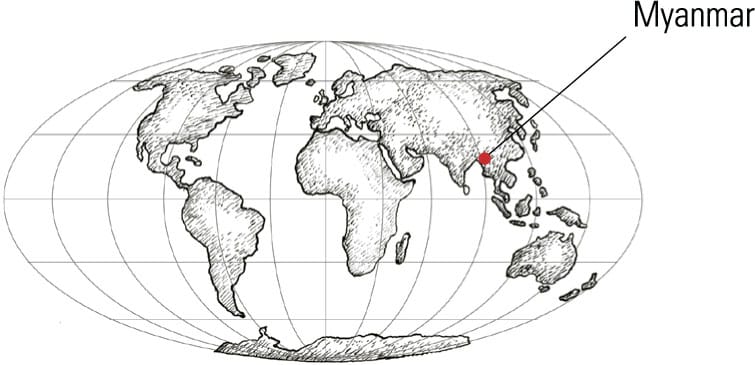


DEVON REX

TOM
With its curly fur, high cheekbones, and pointed ears, it is little wonder that the DEVON REX is often referred to as “The Pixie Cat,” or, for the more sci-fi aware of cat lovers, as “The Alien Cat.” Although the Devon Rex and the Cornish Rex were first discovered in adjacent counties in the UK, genetically the two breeds are completely different.
Features
The Devon Rex has a slightly wedge-shaped head, prominent cheekbones, and a compact muzzle. It has large, low set ears and wide, expressive eyes, which add to its pixie-like features. Its small- to medium-sized compact body is covered with the soft, curly coat that is its defining feature. Its hind legs are longer than its forelegs, which does hinder its ability to play, climb and jump.
Temperament
With behavior best described as “impish.” this mischievous and intelligent cat is fond of exploring and climbing into inaccessible places. It enjoys snuggling on its favorite human’s shoulder, nuzzling close. Needless to say, the Devon is a great family pet.
Similar breeds
Cornish Rex, LaPerm, Selkirk Rex, Sphynx
Size
Tom |
8–9 lb (3.5–4 kg) |
Queen |
6–7 lb (2.5–3 kg) |

Origin
The breed originated in the 1960s from a curly haired feral tom that lived near an abandoned tin mine in Devon, UK. It sired a litter to a domestic female, of which one was a curly haired kitten named Kirlee.



BOMBAY

TOM
While at first glance of a BOMBAY cat, you’re liable to wonder how a small panther has appeared in civilization, there is absolutely no wildcat breed behind it. There are actually two different Bombay breeds—the American Bombay and the British Bombay—though both are striking, solid black cats related to the Burmese.
Features
This unforgettable feline is sleek and muscular at the same time while wrapped in a coat of the deepest, darkest black, with golden or copper eyes (the British Bombay can also have green eyes). Its shiny, tight black coat does little shedding and requires minimal care. A medium-sized cat, its muscles make it heavier than it appears.
Temperament
The Bombay loves other pets when properly introduced. It can be leash-trained and does very well with well-mannered children. Mischievous, intelligent, and playful, this cat will want to be a part of whatever is happening in the house, acting as a four-legged assistant. And when you sit down, this sweet, loving, and people-oriented cat will happily settle into your lap.
Similar breeds
American Shorthair, British Shorthair, Burmese
Size
Tom |
8–11 lb (3.5–5 kg) |
Queen |
6–9 lb (2.5–4 kg) |
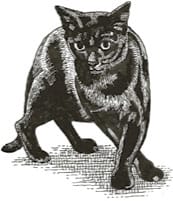
Origin
The American Bombay was created by Nikki Horner of Louisville, Kentucky, who began developing the breed in the 1950s by crossing the black American Shorthair and the sable Burmese. The British Bombay is a slightly more recent breed and is a result of mating a Burmese with a British Shorthair.
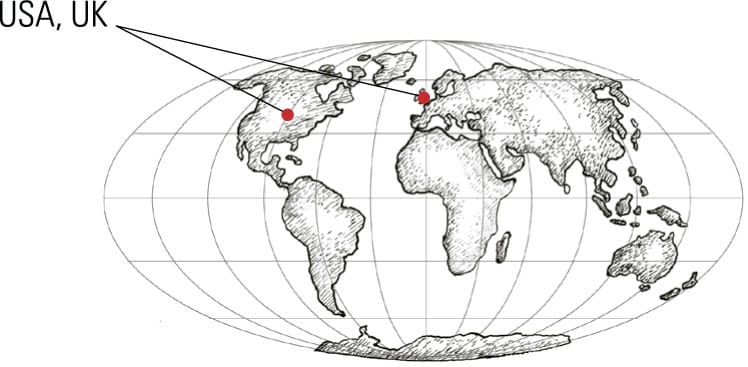


BRITISH SHORTHAIR

QUEEN
The BRITISH SHORTHAIR, colloquially known as the “teddy bear cat,” is one of the UK’s oldest cat breeds and one of the oldest breeds of the Cat Fancy. It is said that it hasn’t changed much since it first arrived with the Roman invasion. Once known as an excellent mouser, this sweet cat will probably spend more time hunting for a toy than any small prey.
Features
With its large, round eyes and smiling face, complete with round cheeks, it’s no wonder that the British Shorthair was allegedly the model for the Cheshire Cat in Lewis Carroll’s Alice in Wonderland. This cat is sturdy, with a dense, thick coat. It can come in a wide range of coat colors, although blue is the most popular.
Temperament
A British Shorthair will get along with other pets and has been known to live happily with dogs, birds, and rabbits. It prefers to have its feet on the ground but it’s content to sit next to its owner. It can be clumsy and have occasional bursts of kittenish energy as an adult.
Similar breeds
British Longhair, Chartreux
Size
Tom |
9–17 lb (4–7.5 kg) |
Queen |
7–12 lb (3–5.5 kg) |
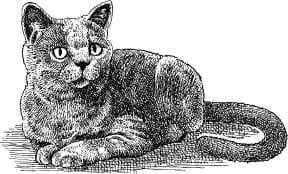
Origin
Despite the breed’s name, the British Shorthair originated in Egypt, arriving in England alongside the Roman invaders, where it found a home and a name in its new country. It was recognized by TICA in 1979 and the CFA in 1980, but it is still quite rare in the USA.



SIBERIAN

TOM
The SIBERIAN is a very old Russian breed dating back hundreds of years, and it has featured in fairytales and children’s books from the 1800s. Originally a working farm cat, the Siberian is considered a Russian national treasure and, for all of its size and power, is an extremely gentle soul. Intelligent enough to problem solve, and playful, it is also adept at comforting those who need it.
Features
This breed reaches its full, impressive size at five years old. It has big paws, slightly longer back legs, and amazing agility. A semi-longhair, it has a triple coat for the Russian winter—this is then shed. Siberians come in a range of coat colors, with striking eyes that are gold to green. Some people consider this cat hypoallergenic.
Temperament
A sweet, calm, loving cat that wants to be near its owners, a Siberian likes children, dogs, and other animals and all manner of toys and games. It clowns about, is partial to jumping or climbing quite high, and communicates in soft trills.
Similar breed
Maine Coon, Norwegian Forest Cat, Turkish Van
Size
Tom |
12–18 lb (5.5–8 kg) |
Queen |
9–14 lb (4–6.5 kg) |
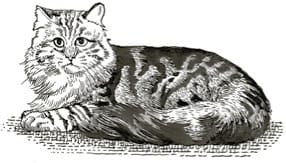
Origin
Prior to the 1800s, there is little documented evidence of this cat’s earliest history in Russia. Although it was recorded that Siberians were shown in 1871 in the UK and in 1884 in the USA, the breed as it is recognized today was first imported into the USA in 1990 and the UK in 2002.


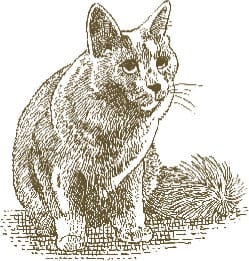
NEBELUNG

TOM
The NEBELUNG is a relatively new breed and still quite rare. It was created to look like the longhaired cats seen in Russia in the early 19th century that were then imported to England. It loves its people but will probably disappear when strangers arrive. Its long blue coat is frosted with silver, giving an ethereal appearance to this intelligent and playful cat.
Features
This medium-sized cat with large ears has been described as both longhaired and medium coated. Its coat is silky to the touch and it has wide-set eyes that can range anywhere from yellowish green to green in color. The Nebelung is sturdy and well muscled.
Temperament
Playful and active, this sweet, loving, and intelligent breed of cat loves to sit on its owner’s lap, and will follow its person from room to room. However, it is essentially shy with strangers and young children and takes time to adjust to new owners and family members.
Similar breed
Havana Brown, Russian Blue, Russian Shorthair
Size
Tom |
8–11 lb (3.5–5 kg) |
Queen |
6–9 lb (2.5–4 kg) |
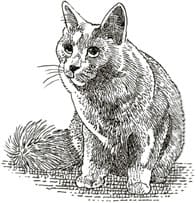
Origin
The Russian Blue was the designated outcross for this breed, which was created in the USA in 1986 from two cats named Brunhilde and Siegfried. The breed was recognized by TICA the following year and granted preliminary recognition by GCCF in 2012.



TONKINESE

TOM
The TONKINESE, one of the most captivating of cats with its amazing aqua eyes and beautiful coat, is actually one of the breeds that feature in the Tamra Maew manuscripts (Thai cat poems written during the Ayudhya Period, 1351–1767). A cross between the Siamese and the Burmese, you simply cannot ignore this gorgeous and good-natured cat.
Features
The first breed with aqua eyes, the Tonk has a short, muscular body with a soft, luxurious coat almost like mink. This coat comes in a dozen colors and pattern varieties, including pointed, mink, and solid varieties; cats in the solid coat color are the only ones to have green to yellow-green eyes.
Temperament
Gregarious and fun loving, a Tonkinese is likely to help greet guests at the door. It is a sweet cat that enjoys discussing the day’s events and loves to play. It is quite capable of inventing its own games and, with its ability to be a lap cat, the Tonkinese can be all things to its lucky owner.
Similar breeds
Bengal, Burmese, Korat, Khao Manee, Siamese
Size
Tom |
8–12 lb (3.5–5.5 kg) |
Queen |
6–8 lb (2.5–3.5 kg) |
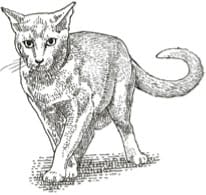
Origin
The Tonkinese first appeared in the UK in the early 19th century. The first Tonkinese cat to be exported to the USA, in 1930, was Wong Mau, originally thought to be a Burmese. The modern Tonkinese was developed from outcrossing Siamese and Burmese in Canada.



SOKOKE

TOM
The SOKOKE, native to Kenya, is so old that there are no records of when the breed began. The Giriama, one of the Nyika tribes of the coastal region of Kenya, were the first people to discover and live with these cats. This rare breed loves its family members, both human and feline alike, and is a very devoted companion.
Features
Graceful, medium-sized, and muscular, the Sokoke has a ticked, modified, classic tabby coat—the distinctive pattern and coloring can actually make it look transparent from a distance.
Temperament
The Sokoke is described as intelligent, curious, sensitive, interactive, intuitive, and peace-loving. It is a moderately active and territorial breed that is well aware of any family hierarchy, not only of pets but of people as well. This cat enjoys being with its owners and as a kitten can create its own games and play for hours on its own.
Similar breed
Abyssinian, Singapura, Somali
Size
Tom |
11–14 lb (5–6.5 kg) |
Queen |
8–11 lb (3.5–5 kg) |
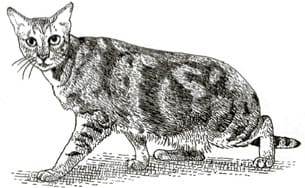
Origin
The Sokoke is bred from feral, wild cats native to Kenya. Known as the Old Line, a set of these cats were imported to Denmark and Italy in the 1980s and 1990s. The New Line also originates in Kenya, and a set of these cats were imported to the USA in the early 2000s to improve the Old Line’s bloodline.



CYMRIC

TOM
The CYMRIC—tailless or possessing a vestigial stump where its tail should be—is a semi-longhaired breed derived from the Manx. Some cat registries consider the Cymric simply to be a Semi-Longhaired Manx, while others recognize it as a separate breed. The name “Cymric” is in recognition of the Manx’s possible Welsh origins—“Cymru” being Welsh for Wales.
Features
This medium-sized cat has a cobby, well-rounded but muscular body, with well-spaced ears and round eyes. Like the Manx, its hind legs are longer than its forelegs, which causes its tailless rump to sit higher than usual, producing an arched appearance. Its coat is medium length and quite dense. The Cymric can be theoretically bred in all colors and patterns, although recognition of these differs between cat registries.
Temperament
An intelligent, curious cat with a gentle disposition, the Cymric is very loyal to its owners and enjoys company, although it does not demand attention. It is playful and enjoys climbing, and it mixes well with other pets.
Similar breeds
Japanese Bobtail, Karelian Bobtail, Kurilian Bobtail, Manx
Size
Tom |
10–12 lb (4.5–5.5 kg) |
Queen |
8–10 lb (3.5–4.5 kg) |
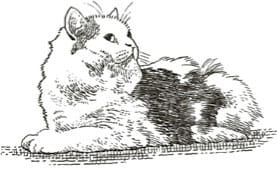
Origin
Cymrics originated in the Isle of Man, though breeders there tried to avoid intentionally breeding kittens with the longhaired gene. However, in Canada during the 1960s, some breeders bred the longhaired Manxes with the aim of producing a new breed. This was to eventually be known as the Cymric.



SINGAPURA

QUEEN
The SINGAPURA is mischief itself, with a lot of personality in a small package. Recognized as a living national treasure in 1991 by the Singaporean government, its ticked coat pattern and dark brown color is native to Southeast Asia. This cat is usually found on the highest perch possible and will like riding on your shoulder where it’s off the ground and can “help” you with whatever you’re doing.
Features
This little imp, the smallest of all cats, comes in only one color, sable brown ticking on an ivory background, which often has yellow tones and fades underneath. Its capivating eyes are celadon green, hazel, gold, or copper.
Temperament
A playful and lively cat known for its intelligence, the Singapura has a desire to interact with its people. Adventurous even in old age, it will only curl up on your lap when it’s ready for a cuddle or a nap. Its personality will captivate you and life will never be dull but it might be exhausting if you don’t channel some of that energy into positive training.
Similar breeds
Abyssinian, Sokoke, Somali
Size
Tom |
6–8 lb (2.5–3.5 kg) |
Queen |
5–6 lb (2–2.5 kg) |
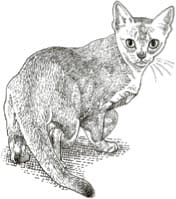
Origin
Though there is some controversy over the Singapura’s origins, it appears that the breed was developed in the USA from three street cats native to Singapore that were imported in the 1970s by Hal and Tommy Meadows. The breed was introduced to the UK in 1988.



EXOTIC SHORTHAIR

TOM
The EXOTIC SHORTHAIR is essentially a shorthaired Persian—or at least a cat of the typical Persian body type with short, dense fur. The breed was developed separately on both sides of the Atlantic and has gone on to gain great popularity. It is the ideal cat for those who love the Persian’s “look” but can’t be bothered to spend a lot of time grooming its fur!
Features
This breed has a medium-sized, cobby but muscular body, a round head with the typical Persian “flattened” face, a small, snub nose, ears rounded at the tips, and large, round eyes. Its fur is thicker than an ordinary shorthaired cat, rather more fluffy and dense. It is bred in a vast range of colors and patterns, including blue, black, lilac, red, tabby, tortoiseshell, and pointed in Persian colors.
Temperament
A gentle, curious cat, the Exotic Shorthair is somewhat less reserved than its Persian ancestors. It is very affectionate and will follow its owner around the house in a dog-like manner. It is playful and outgoing, mixing well with other cats and pets.
Similar breeds
Himalayan/Colorpoint Persian, Persian
Size
Tom |
10–14 lb (4.5–6.5 kg) |
Queen |
7–10 lb (3–4.5 kg) |
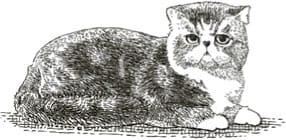
Origin
The breed was developed originally in the USA in the 1970s by crossing Persians with American Shorthairs. A similar development programme was started in the UK in the early 1980s by crossing Persians and British Shorthairs.



OCICAT

QUEEN
The OCICAT does resemble the small wildcat Ocelot species. However, it has no more of a feral genetic background than any other domesticated breed and it is certainly not related to the Ocelot. The Ocicat was created from mating Siamese and Abyssinian cats, with additional mating to American Shorthairs.
Features
The Ocicat has a strong, large body and muscular legs. Its head is wedge shaped, strong jawed, with large ears, rounded at the tips, and almond-shaped eyes ringed with darker fur. Its coat is short and dense, marked with dark contrasting spots. It is bred in varying colors, including tawny, cinnamon, chocolate, and fawn, with the same color variants in silver. Ocicats with a striped rather than spotted coat pattern are known as Ocicat Classics.
Temperament
This breed is extrovert and quite dog-like in its devotion to its owner. Indeed, Ocicats enjoy playing with toys and will play fetch. Its gregarious nature makes it an ideal family pet and it will mix well with other pets as long as they realize that the Ocicat is the boss.
Similar breeds
Abyssinian, American Shorthair, Siamese
Size
Tom |
9–14 lb (4–6.5 kg) |
Queen |
6–9 lb (2.5–4 kg) |

Origin
Created in the USA in the 1960s from a mating of a Siamese and an Abyssinian, the breed’s distinctive markings didn’t appear until the second generation, in the form of a spotted kitten nicknamed “Ocicat.”



LAPERM

TOM
From 1980s American barn cat rex mutation to esteemed show-ring cat today, the striking, curly haired LAPERM has managed to captivate its audience and acquire an active, international group of admirers since its first exhibition.
Features
The LaPerm’s soft coat ranges from wavy to curly, with tighter curls to be found underneath the chin and on the tummy. The coat has been called “The Gypsy Shag” and it comes in every conceivable color and pattern.
Temperament
This active cat is intelligent, curious, and can be fairly easily trained to do any number of tricks. Content also to sit on laps and purr, it loves people as much as people love running their fingers through its curly coat. A LaPerm will enjoy following its owner around, even riding on a shoulder. One way or another, this cat will be with its person.
Similar breed
Cornish Rex, Devon Rex, Selkirk Rex, Sphynx
Size
Tom |
8–10 lb (3.5–4.5 kg) |
Queen |
6–8 lb (2.5–3.5 kg) |

Origin
This breed has its origins in Oregon, USA, where one of Linda Koehl’s brown tabby barn cats gave birth to a hairless kitten; the short, sparse, curly coat that emerged at six weeks was a rex mutation. By the 1990s, Linda had started a whole breeding program for the “LaPerm,” named in honor of its coat.



RUSSIAN BLUE (TICA)

TOM
The RUSSIAN BLUE was imported into the USA in the early 1900s and eventually established itself as a very popular breed among emergent cat fanciers. With its regal bearing and aristocratic expression, it’s easy to see why this cat was beloved of the tzars in its native Russia.
Features
Russian Blue breed standards vary across different associations—the TICA standard calls for a medium-sized cat with a “foreign” type, lithe and muscular body. The wedge-shaped head, with its distinctive, alluring smile, has seven angular plains, high cheekbones, and large flared ears. The coat is short, dense, and blue overall, no other color variant being recognized.
Temperament
The Russian Blue is intelligent and it can form a close bond with its owner. This cat mixes well with other pets and it is very affectionate with children, making it an ideal family pet.
Similar breeds
Havana Brown, Nebelung, Russian Shorthair
Size
Tom |
10–15 lb (4.5–7 kg) |
Queen |
8–15 lb (3.5–7 kg) |
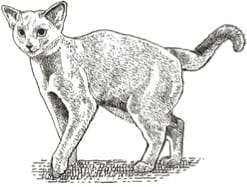
Origin
Although the Russian Blue was introduced to the USA in the early 20th century, serious breeding didn’t take off until after World War II, when American breeders imported both Scandinavian and British cats in order to combine the best features of each.



BURMILLA

QUEEN
The BURMILLA is the happy outcome of accidentally pairing a newly acquired Chinchilla Persian with an escaped lilac Burmese—the four female shorthaired silver kittens with black shading were so beautiful that their owners decided to begin a breeding program for them. This breed’s gorgeous silver coat and bedazzling green eyes are certainly a sight to behold.
Features
Elegant, yet muscular, the adult Burmilla has a sparkling silver coat and green eyes that range from yellowish green to gold when it’s young. This cat has what seems to be “make-up” lining its eyes, nose and lips, making it appear all the more striking. It comes in two coat varieties: shorthaired and semi-longhaired.
Temperament
The sweet Burmilla can be independent but loves its owner and can manage to act like a kitten even when older. This cat can be as impish as a Burmese and as relaxed as a Chinchilla Persian. It loves to play and gets along with other pets in the family as well as children.
Similar breeds
Burmese, Chinchilla Persian, Tiffanie
Size
Tom |
10–12 lb (4.5–5.5 kg) |
Queen |
8–10 lb (3.5–4.5 kg) |

Origin
This new breed began life in the UK, from the accidental mating of a Chinchilla Persian and a lilac Burmese. One of the newer breeds to gain recognition by the cat registries, it is fairly hard to find in the USA.
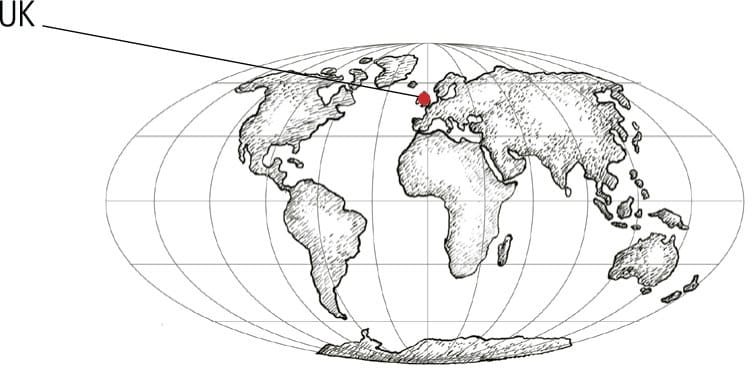


AUSTRALIAN MIST

TOM
The AUSTRALIAN MIST is still a relatively rare breed outside of its native Australia, but these delightful spotted cats—well named for their delicate, almost mist-like coat coloration—give every indication of one day becoming as well known as British and American Shorthairs.
Features
This medium-sized, shorthaired cat has a round head that is delicately marked with bars of color, medium-sized ears, and expressive, round eyes. It has a short coat, with no undercoat, and its spotted coat patterns and base color appear as though veiled, giving an overall “misty” effect. The Australian Mist’s legs and tail are marked with rings or bars and it is bred in brown, blue, chocolate, lilac, gold, and peach.
Temperament
The Australian Mist is a calm, loving cat that thrives on human contact and prefers to stay close to home. Very people-fixated and gregarious, this playful Antipodean feline mixes well with other cats and pets, making it an ideal family pet.
Similar breeds
Abyssinian, American Shorthair, British Shorthair, Burmese
Size
Tom |
10–13 lb (4.5–6 kg) |
Queen |
8–10 lb (3.5–4.5 kg) |
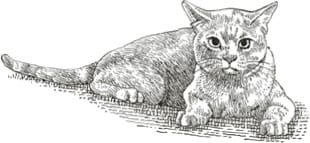
Origin
The breed was developed in Australia in the mid-1970s by crossing Burmese, Abyssinian, and various domestic shorthaired cats. The first Australian Mists were exported to the UK and USA in the early years of the 21st century.



CHARTREUX

TOM
The CHARTREUX, known as “the smiling blue cat of France,” is a very ancient, natural breed renowned for its hunting prowess. There are two competing legends for its name: some believe the cats lived among French Carthusian Monks, makers of the famous Charteuse liqueur; while others claim the name relates to an 18th-century Spanish wool similar to the breed’s dense coat.
Features
One of only three Blue breeds, this cat has rounded eyes that range from gold to copper, with a softly contoured forehead and round head that gently tapers to a narrowed muzzle. The Chartreux has a double coat—a more waterproof outer coat and a woolly undercoat—and its robust body and fine-boned legs have often led to descriptions of it being “a potato on toothpicks.”
Temperament
Very intelligent, this cat enjoys playing fetch and watching birds and television. This sweet, calm cat has a soft chirping voice and tends to follow its people around, sitting next to, rather than on, them. Very stable, it prefers to have its feet on the ground.
Similar breeds
British Shorthair, British Longhair, Persian
Size
Tom |
10–14 lb (4.5–6.5 kg) |
Queen |
6–9 lb (2.5–4 kg) |
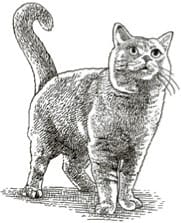
Origin
Probably originating in the Middle East and arriving in France during the Crusades, this natural breed has been noted in French documents since the 16th century. The breed suffered during World War II, after which other breeds, most notably the Persian and the British Shorthair, were introduced.



MANX

QUEEN
One fanciful story about the origins of the MANX is that Noah accidentally cut its tail off when he closed the Ark door. In fact, this cat is a genetic mutation that started within the feline population on the Isle of Man, hence its name, MANX. Kittens born with this mutation were known as either “rumpies”—with no tail at all—or “stumpies”—with a small vestige of a tail.
Features
A medium-sized cat with very rounded features, the Manx is broadchested and firmly muscled with a round head, wide, round eyes and strong legs. Its hind legs are longer than its forelegs, causing its rump to be higher than the shoulder. This, together with the lack of a full tail, gives the cat an overall rounded outline. It can be bred in virtually every coat color and pattern.
Temperament
The Manx is a calm, even-tempered, intelligent cat. It is very people-orientated, forming a strong bond with its people. It is playful and can be quite vocal, demanding attention in its unique, trilling voice. It will mix well with other pets.
Similar breeds
Cymric, Japanese Bobtail, Karelian Bobtail, Kurilian Bobtail
Size
Tom |
10–12 lb (4.5–5.5 kg) |
Queen |
8–10 lb (3.5–4.5 kg) |

Origin
The Manx originated several hundred years ago thanks to a spontaneous genetic mutation among the cats on the Isle of Man. While it is unknown when the cat was first imported into the USA, it was one of the founding breeds when the CFA was created in 1906.



ORIENTAL SHORTHAIR

TOM
The ORIENTAL SHORTHAIR is derived from the Siamese, and from matings with Abyssinian, British Shorthair, and Russian Blue cats. The result is a lively and intelligent cat with the lithe, graceful body contours of the Siamese and similar Oriental-type breeds but with a greater range of coat colors and patterns.
Features
This cat has a long, slender body, and is well muscled with long legs and a whip-like tail. It has a wedge-shaped head, topped off with large, erect ears and striking almond-shaped eyes. Its coat is short and sleek, while its Oriental Longhaired relative has semi-long fur. Both are bred in solid colors, which include cream, red, brown, lilac, and ebony, and various coat patterns including tabby, bi-color, smoke, and shaded.
Temperament
This breed is intelligent, inquisitive, and very sociable. It enjoys human company and will mix well with other animals, making it an ideal family pet. It is very energetic and playful and needs to engage its formidable brain as much as its body.
Similar breeds
Abyssinian, British Shorthair, Russian Blue, Siamese
Size
Tom |
11–14 lb (5–6.5 kg) |
Queen |
9–12 lb (4–5.5 kg) |

Origin
This breed was created in the 1950s in the UK, from matings between Abyssinians, Siamese, British Shorthairs, and Russian Blues. They were imported into the USA in the 1970s and rapidly grew in popularity.



KHAO MANEE

TOM
The KHAO MANEE may be a new breed as far as the Western Cat Fancy is concerned, but it is one of the four ancient Thai breeds (the others being the Siamese, Burmese, and Korat). It is mentioned in Tamra Maew manuscripts. Khao Manee translated means “White Gem,” which sums up this graceful, pure white breed perfectly.
Features
The Khao Manee is a small- to medium-sized cat, with a typical “foreign” body type: lithe and muscular with a tail as long as the body. It has a heart-shaped head with high cheekbones. One of its most notable features is its odd-colored eyes—usually one blue and one amber, although this can vary. It has a shining white coat, made up of short, close-lying fur.
Temperament
This extremely intelligent cat has an outgoing, friendly personality. It will play vigorously or lie on its owner’s lap contentedly in equal measure. If a Khao Manee thinks it’s not getting enough attention, it will simply jump on to your shoulder and tell you it’s there!
Similar breeds
Bengal, Burmese, Korat, Siamese, Tonkinese
Size
Tom |
9–11 lb (4–5 kg) |
Queen |
7–8 lb (3–3.5 kg) |
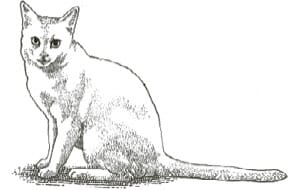
Origin
The Khao Manee is an ancient Thai breed which was greatly favored by Thai royalty. It wasn’t until 1999 that the first Khao Manees were imported into the USA, with further offspring imported to the UK ten years later.



SIAMESE

QUEEN
Stunning looks, natural grace, and a distinctive range of colorations make the SIAMESE instantly recognizable. With a regal visage that evokes visions of Asian palaces and cats living in the lap of luxury as feline gods, this keenly intelligent cat was dubbed “The Royal Cat of Siam” when first exported to the West in the late 1800s.
Features
The Siamese has a slim, well-muscled body with short, fine, sleek fur. It has a wedge-shaped head, with deep blue, almond-shaped eyes and large ears. Its legs are long and elegant, its tail slender. The Siamese is a pointed cat, the extremities of the body being colored, while the main body is white or shaded. The classic Siamese is seal point, although many different variations exist.
Temperament
The Siamese is a very intelligent and affectionate breed which bonds closely with its owners. It has a playful personality and displays dog-like behavior. A Siamese will enjoy being involved in anything of interest! It has a very distinct, loud voice, often mistaken for a baby crying.
Similar breeds
Bengal, Burmese, Korat, Khao Manee, Tonkinese
Size
Tom |
10–15 lb (4.5–7 kg) |
Queen |
8–12 lb (3.5–5.5 kg) |

Origin
The Siamese originated in Thailand, formerly Siam, although cats of a similar type are shown in ancient Egyptian illustrations. The first Siamese exported from Thailand to the USA may have been a gift from an American diplomat in Bangkok to First Lady Lucy Hayes in 1879. Siamese were first bred in the UK in 1884.



SOMALI

TOM
The SOMALI is a stunning cat. With its striking ruddy coloration, large ears, and bushy tail, it’s little wonder that this breed is sometimes known as the “Fox Cat.” It is derived from the Abyssinian, a breed with which it shares many traits. It is a cat possessed of a great curiosity and energy, and this makes it an ideal family pet—if it can sit still long enough!
Features
The Somali is a well-muscled, medium-sized cat, with a silky, semi-longhaired coat. Its head is medium wedge shape, with large ears and almond-shaped eyes that vary in color from green to copper. The body is set off with a magnificent fluffy tail. The “usual” Somali coat is golden brown ticked with black, although it is also bred in a variety of colors, including sorrel (red), silver, blue silver, cream lilac, tabby, and various tortie points.
Temperament
Highly intelligent and inquisitive, the Somali is energetic, loves human company, and will show great loyalty to its owner. Generally speaking, this breed doesn’t like large cat populations where it has to compete for attention.
Similar breed
Singapura, Sokoke
Size
Tom |
8–10 lb (3.5–4.5 kg) |
Queen |
6–7 lb (2.5–3 kg) |

Origin
The Somali originated from longhaired Abyssinian kittens born in the UK in the 1940s then exported to the USA, Canada, Australia, and New Zealand. During the 1960s the breed was developed independently in each country. The Somali’s name is simply due to the fact that Somalia borders Ethiopia, formerly Abyssinia.



SNOWSHOE

QUEEN
The SNOWSHOE is a relatively rare breed. Bred out of the Siamese and American Shorthair, it is a “pointed” cat with a longish, but muscular body. The cat’s name is derived from its distinctive white paws, which look as though it has walked through snow. Highly intelligent, it is one of the very few breeds that actively likes to play in water!
Features
Described as “deceptively powerful,” the Snowshoe has strong musculature. Its head shape is similar to the “applehead” of the “old type” Siamese. It has a short- to medium-length coat, and can be bred in a range of solid colors, with dark points to its face, tail, and ears and sometimes its legs. It will always have blue eyes and white feet.
Temperament
Intelligent and with an extrovert personality, this cat enjoys playing with toys, climbing, and generally making its presence known. It has a distinctive voice, softer than a Siamese. The Snowshoe is fond of playing with running water and enjoys both human and animal company.
Similar breeds
Ragdoll, Siamese
Size
Tom |
9–12 lb (4–5.5 kg) |
Queen |
7–10 lb (3–4.5 kg) |

Origin
The breed originated in the USA in the 1960s when a litter of Siamese kittens was born with white feet. These were later crossed to bicolor American Shorthairs, producing the cat we recognize as the Snowshoe today.



KORAT

QUEEN
The KORAT is an ancient breed from Siam—present-day Thailand—where it is called the “Si-Sawat.” It is one of the seventeen Good Luck Cats to appear in the Tamra Maew manuscripts. Despite its long history, it is possibly the cat that has most retained its original look and, unsurprisingly, it is considered a symbol of good fortune.
Features
This breed’s short, single, silver-tipped blue coat and Peridot green eyes create a striking visual effect, while its somewhat cobby, small- to medium-sized body is comprised of four “heart” shapes, seen by looking at the cat from various perspectives. Muscular and powerful, the Korat is more solid than it appears, with amazing hearing, sight, and smell.
Temperament
A Korat is quite capable of chirping and even roaring but you won’t hear much from it unless it needs to tell you something. Intelligent, athletic, and gentle with children, it prefers a quiet household. A Korat loves to cuddle and sit as closely as possible to its owners.
Similar breeds
Bengal, Burmese, Khao Manee, Siamese, Tonkinese
Size
Tom |
8–10 lb (3.5–4.5 kg) |
Queen |
6–8 lb (2.5–3.5 kg) |
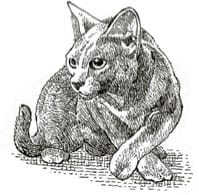
Origin
The Korat is an ancient breed from Siam. The breed may have been shown in England in the late 1800s under the misnomer of “Siamese.” The first Korats were imported into the USA in the late 1950s and all cats imported since then can trace their ancestry back to Thailand.
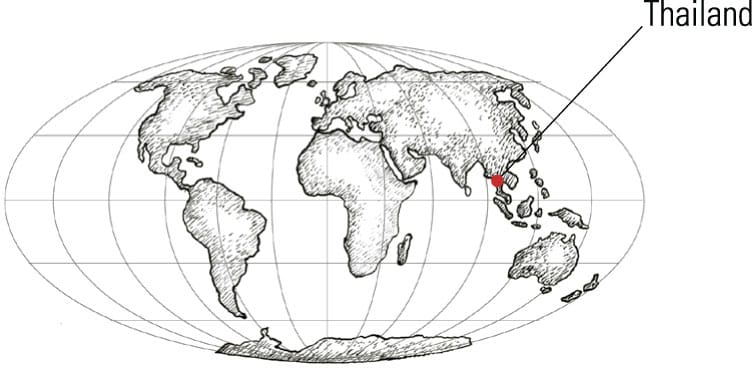


TIFFANIE

QUEEN
The TIFFANIE, a rare jewel of a cat that is slowly gaining popularity, is a semi-longhaired breed that is part of the “Asian” group of varieties, sometimes known by the name of Asian Semi-Longhair. It is recognized by the GCCF in the UK, but not the main USA cat registries (there is also a totally unrelated American breed known as “Tiffany” or “Chantilly”).
Features
The Tiffanie is a medium- to large-sized cat of compact build, similar to its Burmese ancestors, with a firm musculature. It has wide-set ears, round, expressive eyes of varying color and an alert expression. Its fur is semi-longhaired and fine, including a plume-like tail. The Tiffanie can be bred in a wide range of colors and patterns, including black, chocolate, cinnamon, red, lilac, fawn, tabby, shaded, and tortie.
Temperament
The Tiffanie loves to play and get involved in anything of interest but also likes nothing better than to cuddle up on its owner’s lap. It is intelligent but quite possessive of its owner and doesn’t generally mix very well with other pets.
Similar breeds
Burmese, Burmilla, Chinchilla Persian
Size
Tom |
10–15 lb (4.5–7 kg) |
Queen |
8–10 lb (3.5–4.5 kg) |
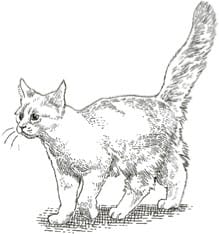
Origin
The Asian group of cats was created in the UK due to an accidental mating between a Chinchilla Persian male and a Burmese female, resulting in the first Burmilla kittens. The longhaired gene inherited from the Chinchilla Persian arose in later Burmillas to give rise to the Tiffanie.


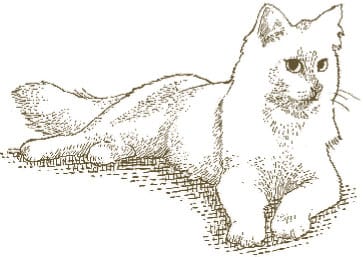
NORWEGIAN FOREST CAT

TOM
The NORWEGIAN FOREST CAT, or Wegie, is thought to be the cat the Vikings took with them to keep their ships rodent-free. Some may have arrived on North America’s east coast with Leif Erickson or someone of that time during the late 10th century. This sweet-natured cat has been named by King Olaf as the official cat of Norway, where it is called Skagkott, or “Forest Cat.”
Features
The Wegie is large and muscular with a semi-longhaired double coat that has a thick undercoat as well as a bushy tail and tufted paws, all to keep it warm in its native Norwegian climate. This cat’s water-resistant coat comes in most colors and becomes thicker in winter, as does its ruff. Its large, almond-shaped eyes and equilateral, triangle-shaped head give it a striking appearance.
Temperament
The Norwegian Forest Cat does very well indoors even though it’s semi-active. A very sweet breed, it loves people and pets alike and will be sure to spend time with its owner, sharing games during its brief bursts of energy and sitting on laps when it suits.
Similar breeds
Maine Coon, Siberian, Turkish Van
Size
Tom |
12–16 lb (5.5–7.5 kg) |
Queen |
9–12 lb (4–5.5 kg) |
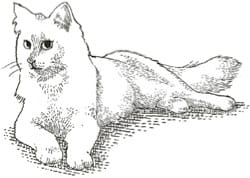
Origin
This natural breed has featured in Norwegian mythology and folk tales for centuries. The breed may have become extinct if not for Norway’s special preservation program started in the 1970s. The breed was first exported to various European countries during the 1970s, then to the USA in 1979 and to the UK in 1987.



BURMESE

QUEEN
Thanks to its huge personality and striking looks, the playful and bright BURMESE is popular all around the world as both a pet and show animal. It is one of the four breeds to originate in Thailand (the others are the Siamese, Korat, and Khao Manee). Its Thai name—“Suphalak”—translates as “beautiful appearance,” which is very appropriate for this regal feline.
Features
The Burmese on both sides of the Atlantic is medium sized, with a surprisingly heavy muscle build. The American-type Burmese has a cobby body and rounded features, while the UK-type has a more triangular, “Oriental-type” face. Both have large, lustrous eyes and shading to face, ears, legs, and tail. This cat has a short, silky coat, the original color of which is brown, but it is available in other colors, depending on the cat registry.
Temperament
This breed is very sociable and likes to be involved in everything that’s going on. Curiosity is a very prominent feature, so a Burmese’s owner can fully expect to have every nook and cranny of the house carefully explored!
Similar breeds
Korat, Siamese, Singapura, Tonkinese
Size
Tom |
9–12 lb (4–5.5 kg) |
Queen |
8–10 lb (3.5–4.5 kg) |

Origin
The modern Burmese was originally introduced to the USA from Thailand in 1930 via a single female cat which was then crossed with a Siamese. In the UK the breed officially began with a pair of Burmese imported from Thailand in 1949.
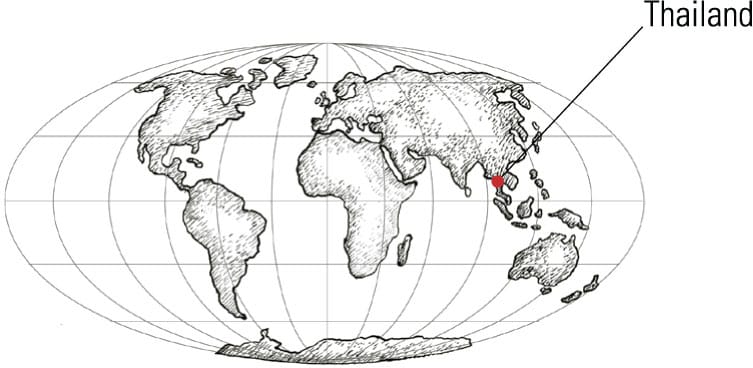


SPHYNX

QUEEN
The SPHYNX is a hairless cat that, with its wrinkled, wizened face, was so named because it also resembles the Egyptian Sphinx of Giza. This loving cat is the result of a recessive hairlessness gene, first seen in the 1960s in a kitten named Prune. This cat may need a wardrobe of sweaters for cold weather and will often sleep under its owner’s blankets at night.
Features
A Sphynx does have some fine hair on its body and some even have discernable hair. Described as feeling like a peach, a warm hot water bottle, or a chamois, the skin of a Sphynx is often oily, requiring skincare, and it usually requires weekly baths. It is a medium-sized cat, but not delicate.
Temperament
Friendly, lively, and inquisitive, this breed gets along with cats and dogs alike. A Sphynx has been known to wrap its arms around its owner’s neck and deliver kisses. It enjoys greeting visitors and will often appear clumsy in a bid for attention. Interestingly, it will use its toes like fingers while checking out something new.
Similar breeds
Cornish Rex, Devon Rex, LaPerm, Selkirk Rex
Size
Tom |
8–11 lb (3.5–5 kg) |
Queen |
6–8lb (2.5–3.5kg) |

Origin
The first hairless kitten appeared in the 1960s, the offspring of a black and white cat, in Ontario, Canada. After much experimentation, by the 1970s, hairless kittens were seen as natural mutations in several parts of North America. Since then they have been bred around the world.

